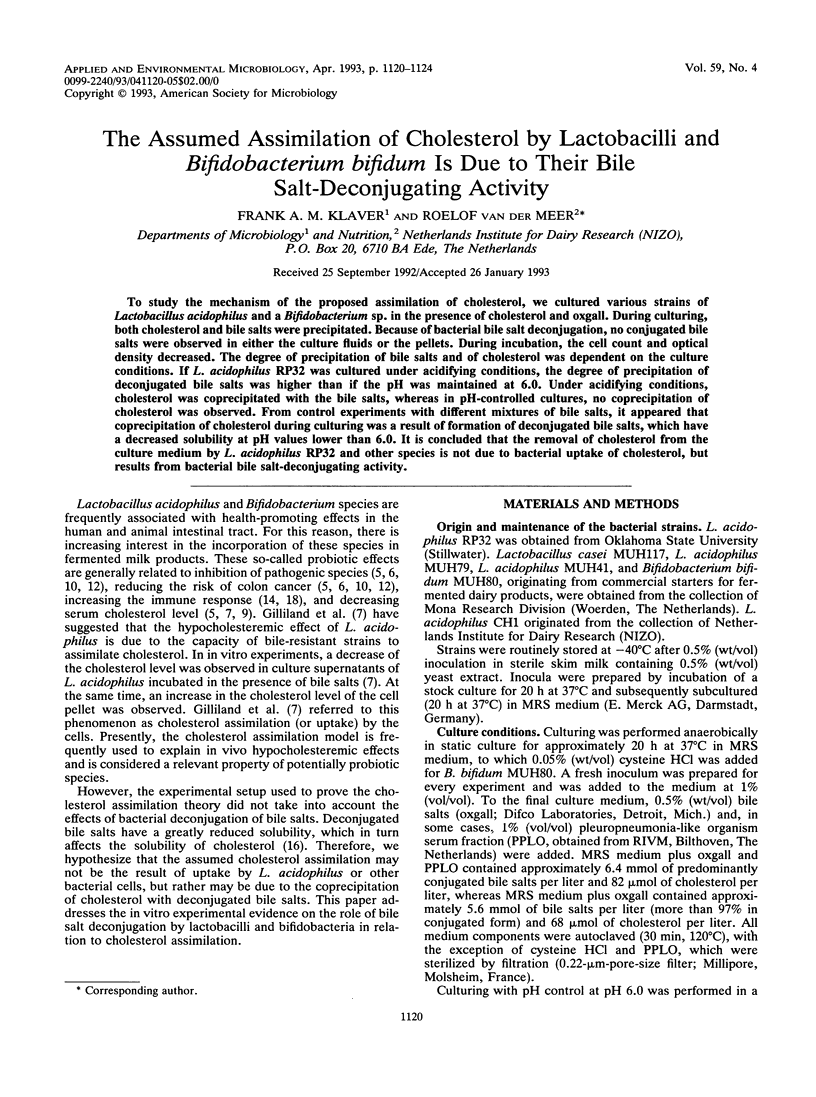Abstract
To study the mechanism of the propsed assimilation of cholesterol, we cultured various strains of Lactobacillus acidophilus and a Bifidobacterium sp. in the presence of cholesterol and oxgall. During culturing, both cholesterol and bile salts were precipitated. Because of bacterial bile salt deconjugation, no conjugated bile salts were observed in either the culture fluids or the pellets. During incubation, the cell count and optical density decreased. The degree of precipitation of bile salts and of cholesterol was dependent on the culture conditions. If L. acidophilus RP32 was cultured under acidifying conditions, the degree of precipitation of deconjugated bile salts was higher than if the pH was maintained at 6.0. Under acidifying conditions, cholesterol was coprecipitated with the bile salts, whereas in pH-controlled cultures, no coprecipitation of cholesterol was observed. From control experiments with different mixtures of bile salts, it appeared that coprecipitation of cholesterol during culturing was a result of formation of deconjugated bile salts, which have a decreased solubility at pH values lower than 6.0. It is concluded that the removal of cholesterol from the culture medium by L. acidophilus RP32 and other species is not due to bacterial uptake of cholesterol, but results from bacterial bile salt-deconjugating activity.
Full text
PDF




Selected References
These references are in PubMed. This may not be the complete list of references from this article.
- ABEL L. L., LEVY B. B., BRODIE B. B., KENDALL F. E. A simplified method for the estimation of total cholesterol in serum and demonstration of its specificity. J Biol Chem. 1952 Mar;195(1):357–366. [PubMed] [Google Scholar]
- Dashkevicz M. P., Feighner S. D. Development of a differential medium for bile salt hydrolase-active Lactobacillus spp. Appl Environ Microbiol. 1989 Jan;55(1):11–16. doi: 10.1128/aem.55.1.11-16.1989. [DOI] [PMC free article] [PubMed] [Google Scholar]
- Fordtran J. S., Locklear T. W. Ionic constituents and osmolality of gastric and small-intestinal fluids after eating. Am J Dig Dis. 1966 Jul;11(7):503–521. doi: 10.1007/BF02233563. [DOI] [PubMed] [Google Scholar]
- Gilliland S. E. Health and nutritional benefits from lactic acid bacteria. FEMS Microbiol Rev. 1990 Sep;7(1-2):175–188. doi: 10.1111/j.1574-6968.1990.tb04887.x. [DOI] [PubMed] [Google Scholar]
- Gilliland S. E., Nelson C. R., Maxwell C. Assimilation of cholesterol by Lactobacillus acidophilus. Appl Environ Microbiol. 1985 Feb;49(2):377–381. doi: 10.1128/aem.49.2.377-381.1985. [DOI] [PMC free article] [PubMed] [Google Scholar]
- Gilliland S. E., Speck M. L. Deconjugation of bile acids by intestinal lactobacilli. Appl Environ Microbiol. 1977 Jan;33(1):15–18. doi: 10.1128/aem.33.1.15-18.1977. [DOI] [PMC free article] [PubMed] [Google Scholar]
- Pekkanen J., Linn S., Heiss G., Suchindran C. M., Leon A., Rifkind B. M., Tyroler H. A. Ten-year mortality from cardiovascular disease in relation to cholesterol level among men with and without preexisting cardiovascular disease. N Engl J Med. 1990 Jun 14;322(24):1700–1707. doi: 10.1056/NEJM199006143222403. [DOI] [PubMed] [Google Scholar]
- Perdigon G., de Macias M. E., Alvarez S., Oliver G., de Ruiz Holgado A. A. Effect of perorally administered lactobacilli on macrophage activation in mice. Infect Immun. 1986 Aug;53(2):404–410. doi: 10.1128/iai.53.2.404-410.1986. [DOI] [PMC free article] [PubMed] [Google Scholar]
- Reynier M. O., Montet J. C., Gerolami A., Marteau C., Crotte C., Montet A. M., Mathieu S. Comparative effects of cholic, chenodeoxycholic, and ursodeoxycholic acids on micellar solubilization and intestinal absorption of cholesterol. J Lipid Res. 1981 Mar;22(3):467–473. [PubMed] [Google Scholar]
- Van der Meer R., Termont D. S., De Vries H. T. Differential effects of calcium ions and calcium phosphate on cytotoxicity of bile acids. Am J Physiol. 1991 Jan;260(1 Pt 1):G142–G147. doi: 10.1152/ajpgi.1991.260.1.G142. [DOI] [PubMed] [Google Scholar]
- Yasui H., Mike A., Ohwaki M. Immunogenicity of Bifidobacterium breve and change in antibody production in Peyer's patches after oral administration. J Dairy Sci. 1989 Jan;72(1):30–35. doi: 10.3168/jds.S0022-0302(89)79076-7. [DOI] [PubMed] [Google Scholar]


